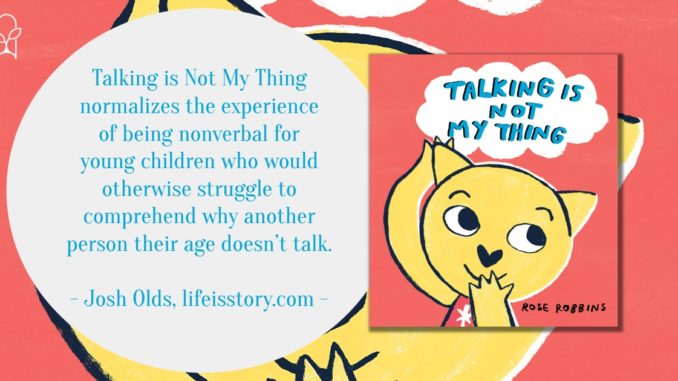
Published by Eerdmans Books for Young Readers on September 8, 2020
Genres: Children's
Buy on Amazon
Goodreads

This little sister might not use words, but she’s got plenty to say! Narrated through thought bubbles, this energetic book invites readers into the day of a nonverbal girl with autism. She has so much to do—games to play, spaghetti to eat, and a missing stuffed animal to find! Sometimes life can be noisy and overwhelming, but something new is always around the corner. Talking isn’t the only way to make a joke, ask for Grandma’s help, or surprise your brother…
Illustrated in bright colors, Talking Is Not My Thing is a joyful portrait of neurodiverse family life.
Many children who have speech or language delays are fully able to nonverbally communicate and understand verbal instruction. One of the best things you can do for a nonverbal child to help develop their language skills is to talk to them, interact with them, and read to them. I know all of this because my three-year-old struggles with language delays and my wife and I—both early and voluminous communicators—had to adapt to raising a child who was not like us.
Talking Is Not My Thing is a story told from the perspective of a nonverbal character with autism spectrum disorder. Her words come in thought bubbles as she responds in her mind with the verbal prompts those around give her. Come inside! It’s nearly dinner, Brother says. I don’t speak. But my brother finds it easy. Through the book, you see how a nonverbal child might respond to verbal prompts or how they might communicate.
In one panel, the young girl tries to use her voice, but all that comes out is “EEP?” She thinks, Sometimes I try to use my voice, but the words don’t come out right. As a parent with a child who struggles to communicate, this panel nearly wrecked me with its clarity and simplicity. Nonverbal children want to communicate. Nonverbal children want to have their needs and wants known and understood. They work so hard and yet it’s still such a struggle. I’ve seen it in my own son whose frustrations to be understood leads to an even further degradation of language skills. It’s just rough.
Another panel shows her as being sensitive to loud sounds like conversation at the dinner table. These kinds of sensory processing issues often go hand-in-hand with ASD and/or language delays. In another, the girl uses flashcards to help Grandma understand that she needs to go to the bathroom. The whole book is the day in the life of a child with autism, written in a way that clear and understandable to other children. This book is a must-have for siblings and playmates to understand the needs of their neurodivergent siblings and friends.
There’s no discussion of autism as a disorder or about it being something “less than.” It’s simply portrayed as being different. The voices of the voiceless are often left out of literature and to see a nonverbal child take center stage in a children’s book brings me to tears. Every school library needs this. Every church library needs this. Every family who interacts with neurodivergent individuals (and that should be all of us) needs this.
Talking is Not My Thing normalizes the experience of being nonverbal for young children who would otherwise struggle to comprehend why another person their age doesn’t talk. It teaches them how nonverbal individuals communicate and how to care for and listen to them. A beautiful, incredible book.
